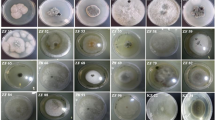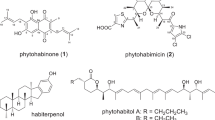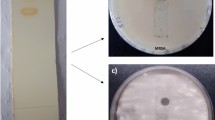Abstract
We have screened microbial culture filtrates for nitrogen monoxide (NO) production inhibitors using mouse macrophage cell line RAW264.7. As a result, paxilline, 21-isopentenylpaxilline and a novel analog of paxilline have been isolated from the culture filtrate of fungus Eupenicillium shearii. The novel analog possesses an additional dihydropyran ring, and was named as pyrapaxilline. This compound inhibited the NO production with lower toxicity than paxilline.
Similar content being viewed by others
Introduction
Nitrogen monoxide (NO) produced by endothelial nitric oxide synthase often has an important role regulating many physiological functions such as vasodilation and neurotransmission. However, overproduction of NO by inducible NO synthase mainly in macrophages often accelerates inflammatory diseases including atherosclerosis, rheumatoid arthritis, septic shock, multiple sclerosis, diabetes mellitus and graft rejection.1 Therefore, suppression of NO production or inducible NO synthase expression might be important for the treatment of inflammatory disorders. Lipopolysaccharide (LPS) induces inducible NO synthase expression that is mainly mediated by transcription factor NF-κB (nuclear factor-κB). Therefore, screening of LPS-induced NO production inhibitors may provide new NF-κB inhibitors. We previously designed a novel NF-κB inhibitor dehydroxymethylepoxyqinomicin from the structure of antibiotic epoxyquinomicin C.2, 3 It showed potent anti-inflammatory and anticancer activities in animals.4 We also isolated a known glutarimide compound, 9-methylstreptimidone5 from the culture filtrate of Streptomyces and known penicillic acid and dihydropenicillic acid6 from a fungus Penicillium as inhibitors of NF-κB. These NF-κB inhibitors except dehydroxymethylepoxyqinomicin were isolated first as NO production inhibitors. Therefore, screening of LPS-induced NO production inhibitors may provide further effective anti-inflammatory agents. Then, we looked for the novel inhibitors among microbial secondary metabolites. As a result, we found a novel paxilline analog named pyrapaxilline from the static culture filtrate of fungus Eupenicillium shearii.
Results
The producing strain and isolation
We have prepared and screened about 1000 microbial filtrates for NO production inhibitors. Microbial culture filtrate from a fungus PF1443 (CR25679) showed potent inhibitory activity on LPS-induced NO production. The producing organism was identified to be E. shearii as described in Methods. For the purification of active principle, static culture of this fungus was extracted with 67% aq acetone and then EtOAc to give a dried brown residue. The residue was subjected to column chromatography on silica gel 60. After the concentration of active fractions, the yellow residue was obtained. The MeOH solution of this residue was further purified on HPLC column to give three compounds (1–3). Compounds 1 and 2 were identified as paxilline7 and 21-isopentenylpaxilline,8 respectively, from their spectral data. The spectral data of compound 3 had never been reported, and was shown to be a novel analog of 1 (Figure 1).
Structure elucidation
The molecular formula of 3 was determined as C37H47NO5 by HRESIMS. The 2D NMR analysis in CD3OD (Table 1) and NOESY experiment in (CD3)2SO (Figure 2) exhibited to be an indole-diterpene having an additional substituted dihydropyran ring linked with the indole unit of 1. The paxilline moiety at C-21 and C-22 (that is, C-29 in 3), fused with five-membered ring of the indene portion, biogenetically derived from two isopentenyl side chains9 (Figure 1). The numbering of 3 is shown according to that of janthitrems10 and shearinines.8, 11 The 1H and 13C NMR spectra of 3 were measured in CD3OD rather than in CDCl3, because the structural change occurred in the latter solvent.10 The linkage of the dihydropyran and five-membered rings at C-23 and C-28 was established by NOESY experiment in (CD3)2SO. The NOE correlations of 30-H (δ 7.01) to 27-H (δ 2.33) and to 1-NH (δ 10.56) were observed (Figure 2). Among the known paxilline-related compounds, shearinine B8 (4) has the same molecular formula with 3. But, the structure of 3 at C-23 and C-27 was different from those of 4. In 1H NMR data of 3 (Table 1), unisochronous methylene proton signals at δ 2.44 and 2.59 (AB quartet), assigned to 27-H2, were shown, instead of an olefinic 27-H and an aliphatic 23-H signals in those of 4.8 In comparison of the 13C NMR data in CDCl3 and the optical rotation values of 1 and 3, it is suggested that 1 and the paxilline moiety of 3 have the same stereochemistry. The absolute structure of 1 was already determined by X-ray crystallographic analysis.7 The 13C chemical shifts of 3 at C-2→C-18 were closely similar to those of 1 and 2. Furthermore, 3 was levorotatery, [α]D21 −11° (MeOH), as similar to those of 1, [α]D25 −6.0° (MeOH). The stereostructure of 3 was elucidated as shown in Figure 1, and also confirmed in comparison with the NMR data of shearinine F.11
Biological activities
LPS increased NO production about 2.5 times over the basal level after 20 h. When RAW264.7 cells were pretreated with 3 for 2 h prior to LPS stimulation, 3 inhibited LPS-induced NO production at 10–30 μg ml−1 without toxicity (Figure 3). Compound 3 inhibited 40% of NO production.
Inhibition of lipopolysaccharide (LPS)-induced nitrogen monoxide (NO) production by pyrapaxilline (3) in RAW264.7 cells. The LPS stiumulated-RAW264.7 cells were treated with 3 for 20 h then the NO production and cell number were assayed. Values are the means±s.d. of triplicate determinations. *P<0.0005 against column of 0 μg ml−1.
Paxilline (1) is known to inhibit high-conductance Ca-activated K channels,12 and it was reported to inhibit LPS-induced IκB-α/NF-κB signaling in macrophages.13 In our assay system, 1 inhibited the NO production at 10 μg ml−1. Compound 2 was shown to inhibit NO production only weakly at 30 μg ml−1.
Discussion
In the course of screening for the inhibitors of NO production, we have isolated paxilline and its two related compounds from the culture of fungus E. shearii. They are paxilline (1), 21-isopentenylpaxilline (2) and a novel compound 3. Novel analog (3) inhibited LPS-induced NO production at 10–30 μg ml−1 without toxicity. Compound 3 possesses an additional dihydropyran ring, and was named as pyrapaxilline. The structure of 3 was appeared as shearinine B isomer in a patent application14 together with many paxilline-related compounds. But, its data of characterization and structural determination of this compound have never been reported. Therefore, we have reported isolation and characterization of pyrapaxilline (3) as a novel compound in the present research.
Methods
General experimental procedures
The EI-MS was measured with a JEOL GC Mate spectrometer (JEOL, Tokyo, Japan). HRESIMS was taken with a Waters LCT Premier XE spectrometer (Waters, Milford, MA, USA). NMR spectra were recorded on a JEOL JNM-ECA500 spectrometer (JEOL). The 1H and 13C chemical shifts were referenced to the solvent signal (δH 7.26 and δC 77.16 in CDCl3, δH 3.31, δC 49.0 in CD3OD and δH 2.50, δC 39.5 in (CD3)2SO). The UV spectra were recorded on a Hitachi U-3310 spectrophotometer (Hitachi, Tokyo, Japan). Optical rotations were measured on a JASCO P-2200 polarimeter (JASCO, Tokyo, Japan). IR spectra were recorded on a Bruker FT-IR ALPHA-T spectrometer (Bruker Optics K.K., Tokyo, Japan).
Identification of producing strain and fermentation
Fungal strain PF1443 (CR25679) was isolated from a soil sample collected at Okinawa, Japan. The phenotypic and genotypic data including base-sequence analyses of 28S rDNA-D1/D2 and ITS-5.8S rDNA showed that this strain belongs to E. shearii. A slant culture of PF1443 (CR25679) was used to inoculate in 100-ml Erlenmeyer flasks. Each flask contained 20 ml of a seed medium consisting of 2.0% soluble starch, 1.0% glucose, 0.5% polypeptone, 0.6% wheat germ, 0.3% yeast extract, 0.2% soybean meal and 0.2% CaCO3 in deionized water adjusted to pH 7.0 with NaOH aq solution prior to sterilization. The flasks were incubated at 25 °C for 3 days on a rotary shaker at 220 r.p.m. Portions of 1.0 ml of this seed culture were transferred into two 500-ml Erlenmeyer flasks, each of which contained 100 ml of a seed medium. The flasks were incubated at 25 °C for 48 h on a rotary shaker at 220 r.p.m. Portions of 150 ml of the second seed culture were transferred into a stainless vat containing the solid culture medium consisting of 100 g of oatmeal and 4.0 kg of water-absorbed brown rice. The stainless vat was thoroughly stirred and then statically cultured at 25 °C for 14 days.
Extraction and isolation
The obtained culture (4.0 kg) was extracted with 8.0 liters of 67% aq acetone. The extract (twice, 15.0 liters in total) was evaporated under reduced pressure to about a quarter of the original volume, and then extracted twice with 15.0 liters of EtOAc at pH 2.0, and the extract was evaporated to give a brown residue (21.9 g). The residue was chromatographed on a silica gel column (Silica gel 60, 500 g, 0.063–0.200 mm, Merck KGeA, Darmstadt, Germany,column size: 50 × 500 mm) and cut into 550 fractions (each 20 ml), using hexane-EtOAc (3:1). The major active fractions no. 350–500 were combined and concentrated to yellow residue (832 mg), showing an RF of 0.67 on a silica gel TLC using hexane–EtOAc (3:1). The residue of 30 mg was dissolved in MeOH and separated by HPLC (Pegasil ODS C18 column, 5 μm, Senshu Scientific, Tokyo, Japan; column size: 20 × 250 mm, H2O/CH3CN: 30/70-5/95, 8 ml min−1) to obtain pure paxilline (1; 6.0 mg, Rt 18 min), 21-isopentenylpaxilline (2) (2.4 mg, Rt 28 min) and pyrapaxilline (3) (2.4 mg, Rt 32 min).
Paxilline (1). Colorless solid: [α]25D −6° (c 0.0867, MeOH); 13C NMR (125 MHz, CDCl3) δ 199.3, 168.4, 151.6, 139.8, 125.1, 120.7, 119.8, 119.5, 118.6, 117.5, 111.5, 83.3, 77.5, 72.7, 72.6, 50.9, 49.5, 43.2, 34.3, 28.5, 28.0, 27.2, 26.6, 24.2, 20.9, 19.7 and 16.5; EI-MS m/z 435 (M+, calcd for C27H33NO4, 435).
21-Isopentenylpaxilline (2). Yellowish oil; 13C NMR (125 MHz, CDCl3) δ 199.6, 168.5, 152.1, 138.6, 133.7, 131.8, 125.6, 124.9, 121.8, 120.0, 118.0, 117.5, 111.7, 83.6, 77.9, 72.9, 72.8, 51.1, 49.8, 43.5, 34.9, 34.7, 28.8, 28.3, 27.5, 26.9, 26.2, 24.5, 21.2, 20.0, 18.2 and 16.6; EI-MS m/z 503 (M+, calcd for C32H41NO4, 503); HRESIMS m/z 504.3094 [(M+H)+, calcd for C32H42NO4, 504.3114].
Pyrapaxilline (3). Pale yellow solid: [α]D25 −11° (c 0.2333, MeOH); UV λmaxMeOH (ɛ) 243 (11 000), 283 (sh, 6600) and 316 (sh, 4100) nm; IR (KBr) νmax 3412, 2973, 2930, 1665, 1453, 1376, 1162 and 1119 cm−1; 1H NMR (500 MHz) and 13C NMR data (125 MHz) in CD3OD are shown in Table 1; NOESY experiment in (CD3)2SO showed NOE correlations among 20-H to 22-H, 30-H to 27-H and 1-NH to 30-H (Figure 2); 13C NMR (125 MHz, CDCl3) δ 199.4, 168.4, 151.0, 143.2, 139.8, 139.8, 133.5, 131.8, 120.3, 119.7, 117.3, 113.8, 101.1, 83.3, 77.4, 72.8, 72.6, 72.6, 71.2, 51.0, 49.3, 43.3, 36.8, 34.5, 34.5, 30.4, 30.4, 29.8, 29.7, 28.6, 28.1, 26.7, 26.7, 24.3, 21.0, 19.8 and 16.2; EI-MS m/z 585 (M+, calcd for C37H47NO5, 585); HRESIMS m/z 586.3553 [(M+H)+, calcd for C37H48NO5, 586.3532].
Cell culture
Mouse macrophage RAW264.7 cells were cultured in Dulbecco’s modified Eagle’s medium (Nissui, Tokyo, Japan) supplemented with 10% fetal bovine serum (JRH Biosciences, Lenexa, KS, USA), 200 μg ml−1 kanamycin (Sigma, St Louis, MO, USA), 100 units ml−1 penicillin G (Sigma), 600 μg ml−1 L-glutamine (Sigma) and 2.25 g l−1 NaHCO3 under a humidified atmosphere with 5% CO2 and 95% air at 37 °C.
NO production
Cells (1 × 105 cells ml−1) were seeded in a 96-well plate (Corning, Corning, NY, USA) with each well receiving 100 μl of the cell suspension.15 On the next day, the cells were treated with chemicals for 2 h and then stimulated with 1 μg ml−1 LPS for 20 h. Then, 100 μl Griess reagent solution was added to each well. The concentration of NO was determined by measuring the absorbance at 570 nm with a microplate reader.
MTT assay
Cell suspension (1 × 105 cells ml−1) of RAW264.7 cells at concentration of 50% confluence was seeded into the 96-well plate. Then, the cell suspensions were added into the plates and incubated for 20 h. Next, 10 μl of the MTT (3-[4,5-dimethylthiazol-2-yl]-2,5-diphenyltetrazolium bromide, Sigma) solution was added into each plate and incubated for 4 h at 37 °C under 5% CO2. Subsequently, the culture supernatant was replaced with 100 μl dimethyl sulfoxide to dissolve formazan crystal made from succinic dehydrogenase in the mitochondria and its substrate MTT. An absorbance of 570 nm was measured with a microplate reader.
References
Korhonen, R., Lahti, A., Kankaanranta, H. & Moilanen, E. Nitric oxide production and signaling in inflammation. Curr Drug Targets Inflamm Allergy 4, 471–479 (2005).
Ariga, A., Namekawa, J., Matsumoto, N., Inoue, J. & Umezawa, K. Inhibition of tumor necrosis factor-alpha-induced nuclear translocation and activation of NF-kappa B by dehydroxymethylepoxyquinomicin. J. Biol. Chem. 277, 24625–24630 (2002).
Suzuki, Y., Sugiyama, C., Ohno, O. & Umezawa, K. Preparation and biological activities of optically active dehydroxymethylepoxyquinomicin, a novel NF-κB inhibitor. Tetrahedron 60, 7061–7066 (2004).
Umezawa, K. Inhibition of tumor growth by NF-κB inhibitors. Cancer Sci. 97, 990–995 (2006).
Wang, Z., Igarashi, M., Ikeda, Y., Horie, R. & Umezawa, K. Inhibition of NF-kappa B activation by 9-methylstreptimidone isolated from Streptomyces. Heterocycles 69, 377–383 (2006).
Tachibana, M., Matsui, C., Takeuchi, Y., Suzuki, E. & Umezawa, K. Inhibition of NF-κB activation by penicillic acid and dihydropenicillic acid isolated from fungi. Heterocycles 76, 1561–1569 (2008).
Springer, J. P., Clardy, J., Wells, J. M., Cole, R. J. & Kirksey, J. W. The structure of paxilline, a tremorgenic metabolite of Penicillium paxilli Bainier. Tetrahedron Lett. 16, 2531–2534 (1975).
Belofsky, G. N., Gloer, J. B., Wicklow, D. T. & Dowd, P. F. Antiinsectan alkaloids: Shearinines A-C and a new paxilline derivative from the ascostromata of Eupenicillium shearii. Tetrahedron 51, 3959–3968 (1995).
Singh, S. B. et al. Nodulisporic acids D-F: structure, biological activities, and biogenetic relationships. J. Nat. Prod. 67, 1496–1506 (2004).
Wilkins, A. L. et al. Structure elucidation of janthitrem B, a tremorgenic metabolite of Penicillium janthinellum, and relative configuration of the A and B rings of janthitrems B, E, and F. J. Agric. Food Chem. 40, 1307–1309 (1992).
Xu, M. et al. Shearinines D-K, new indole triterpenoids from an endophytic Penicillium sp. (strain HKI0459) with blocking activity on large-conductance calcium-activated potassium channels. Tetrahedron 63, 435–444 (2007).
Knaus, H. G. et al. Tremorgenic indole alkaloids potently inhibit smooth muscle high-conductance calcium-activated potassium channels. Biochemistry 33, 5819–5828 (1994).
Papavlassopoulos, M. et al. MaxiK blockade selectively inhibits the lipopolysaccharide-induced I kappa B-alpha/NF-kappa B signaling pathway in macrophages. J. Immunol. 177, 4086–4093 (2006).
Goetz, M. A. et al. (Merck & Co. Inc.). Novel maxi-k channel blockers, methods of use and process for making the same. WO 03/105868, 24 December (2003).
Dubois, R. N. et al. Cyclooxygenase in biology and disease. FASEB J 12, 1063–1073 (1998).
Acknowledgements
We thank Dr Shinichi Kondo, Bioscience Associates, Tokyo, for his valuable suggestions.
Author information
Authors and Affiliations
Corresponding author
Ethics declarations
Competing interests
The authors declare no conflict of interest.
Rights and permissions
About this article
Cite this article
Matsui, C., Ikeda, Y., Iinuma, H. et al. Isolation of a novel paxilline analog pyrapaxilline from fungus that inhibits LPS-induced NO production. J Antibiot 67, 787–790 (2014). https://doi.org/10.1038/ja.2014.63
Received:
Revised:
Accepted:
Published:
Issue Date:
DOI: https://doi.org/10.1038/ja.2014.63
This article is cited by
-
The chemical structures and biological activities of indole diterpenoids
Natural Products and Bioprospecting (2023)
-
Inhibition of cellular inflammatory mediator production and amelioration of learning deficit in flies by deep sea Aspergillus-derived cyclopenin
The Journal of Antibiotics (2020)
-
Novel p-terphenyl glycoside with a rare 2,6-dideoxyhexopyranose moiety from Actinomycete strain SF2911 that inhibits cancer cell migration
The Journal of Antibiotics (2017)






